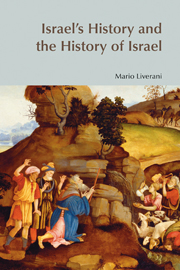Book contents
- Frontmatter
- Dedication
- Contents
- List of Tables and Illustrations
- Foreword
- Abbreviations
- IMPRINTING
- Part I A NORMAL HISTORY
- Chapter 2 THE TRANSITION (TWELFTH CENTURY)
- Chapter 3 THE NEW SOCIETY (c. 1150–1050)
- Chapter 4 THE FORMATIVE PROCESS (c. 1050–930)
- Chapter 5 THE KINGDOM OF ISRAEL (c. 930–740)
- Chapter 6 THE KINGDOM OF JUDAH (c. 930–720)
- Chapter 7 THE IMPACT OF THE ASSYRIAN EMPIRE (c. 740–640)
- Chapter 8 PAUSE BETWEEN TWO EMPIRES (c. 640–610)
- Chapter 9 THE IMPACT OF THE BABYLONIAN EMPIRE (c. 610–585)
- INTERMEZZO
- Part II AN INVENTED HISTORY
- EPILOGUE
- Bibliography
- Index of References
- Index of Names of Persons and Deities
- Index of Placenames
Chapter 4 - THE FORMATIVE PROCESS (c. 1050–930)
from Part I - A NORMAL HISTORY
- Frontmatter
- Dedication
- Contents
- List of Tables and Illustrations
- Foreword
- Abbreviations
- IMPRINTING
- Part I A NORMAL HISTORY
- Chapter 2 THE TRANSITION (TWELFTH CENTURY)
- Chapter 3 THE NEW SOCIETY (c. 1150–1050)
- Chapter 4 THE FORMATIVE PROCESS (c. 1050–930)
- Chapter 5 THE KINGDOM OF ISRAEL (c. 930–740)
- Chapter 6 THE KINGDOM OF JUDAH (c. 930–720)
- Chapter 7 THE IMPACT OF THE ASSYRIAN EMPIRE (c. 740–640)
- Chapter 8 PAUSE BETWEEN TWO EMPIRES (c. 640–610)
- Chapter 9 THE IMPACT OF THE BABYLONIAN EMPIRE (c. 610–585)
- INTERMEZZO
- Part II AN INVENTED HISTORY
- EPILOGUE
- Bibliography
- Index of References
- Index of Names of Persons and Deities
- Index of Placenames
Summary
The Palestinian Mosaic in a Widened Horizon
The processes that formed those political entities we can properly define as ‘Israelite’ can be explained in the light of several major factors. The collapse of the Late Bronze regional system left the entire Near East autonomous, with freedom of action unrestrained by any external influence. The crisis that befell the central palace institution gave the agro-pastoral component a more relevant political-institutional and socio-economic role (as compared with the recent past). Technological innovation and tribal settlement together brought about a demographic surge and opened up new cognitive, economic and political horizons, in a spatial as well as a social sense.
Israelite tribes were not the only ones to enter this scenario. They were in contact with other groups with whom they felt more or less related, and were economically more or less complementary or competitive in the use of resources. It is interesting to note how independence and complementarity characterize relationships with the old (and new) city-states, but affinity and competition with other peoples of tribal origin and with a similar ‘national’ political feeling. Conflict with the former could be radical, even violent, and led to serious crises, but in the long run it gave rise to complex and substantially stable solutions. The conflict with the latter tended rather to remain permanent, having roots in common feelings, and in a similar approach to land use.
- Type
- Chapter
- Information
- Israel's History and the History of Israel , pp. 77 - 103Publisher: Acumen PublishingPrint publication year: 2005



